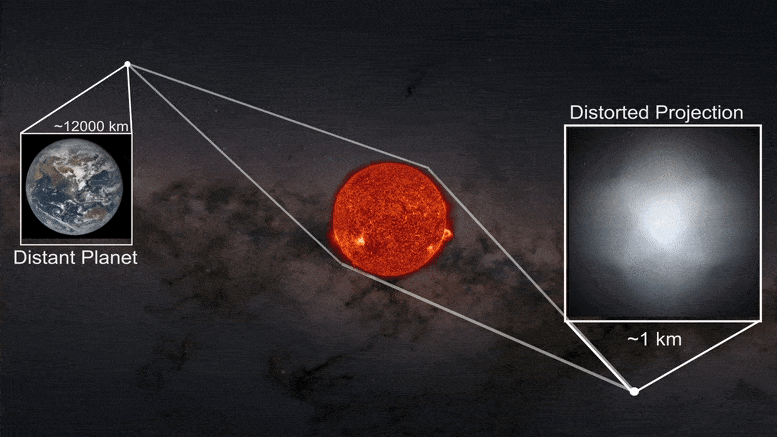Stanford’s Futuristic Gravity Telescope Could Image Exoplanets – 1,000x More Powerful

A futuristic technique conceptualized by Stanford University scientists could empower astronomical imaging far more advanced than what is presently possible. Credit: Alexander Madurowicz
A futuristic “gravity telescope” technique conceptualized by Stanford astrophysicists could enable astronomical imaging significantly more advanced than any present today.
In the time since the first discovered more than 5,000 planets orbiting other stars. However, when astronomers detect a new exoplanet, we learn relatively little about it: we know that it exists and a few features about it, but the rest is a mystery.
To sidestep the physical constraints of telescopes, Stanford University astrophysicists have been developing a new conceptual imaging technique that would be 1,000 times more precise than the strongest imaging technology currently in use. By taking advantage of gravity’s warping effect on space-time, called gravitational lensing, scientists could potentially manipulate this phenomenon to create imaging far more advanced than any currently available.
In a paper published today (May 2, 2022) in The Astrophysical Journal, the researchers describe a way to manipulate solar gravitational lensing to view planets outside our solar system. By positioning a telescope, the sun, and exoplanet in a line with the sun in the middle, scientists could use the gravitational field of the sun to magnify light from the exoplanet as it passes by. As opposed to a magnifying glass which has a curved surface that bends light, a gravitational lens has a curved space-time that enables imaging far away objects.

An example of a reconstruction of Earth, using the ring of light around the Sun, projected by the solar gravitational lens. The algorithm that enables this reconstruction can be applied to exoplanets for superior imaging. Credit: Alexander Madurowicz
“We want to take pictures of planets that are orbiting other stars that are as good as the pictures we can make of planets in our own solar system,” said Bruce Macintosh, a physics professor at in the School of Humanities and Sciences at Stanford and deputy director of the Kavli Institute for Particle Astrophysics and Cosmology (KIPAC). “With this technology, we hope to take a picture of a planet 100 light-years away that has the same impact as Apollo 8’s picture of Earth.”
The catch, at present, is that their proposed technique would require more advanced space travel than is currently available. Still, the promise of this concept and what it could reveal about other planets, makes it worth continued consideration and development, said the researchers.
The perks of light bending
Gravitational lensing wasn’t experimentally observed until 1919 during a solar eclipse. With the moon obstructing the light from the sun, scientists were able to see stars near the sun offset from their known positions. This was unequivocal proof that gravity could bend light and the first observational evidence that Einstein’s theory of relativity was correct. Later, in 1979, Von Eshleman, a Stanford professor, published a detailed account of how astronomers and spacecraft could exploit the solar gravitational lens. (Meanwhile, astronomers including many at Stanford’s KIPAC now routinely use the powerful gravity of the most massive galaxies to study the early evolution of the universe.)
But it wasn’t until 2020 that the imaging technique was explored in detail in order to observe planets. Slava Turyshev of California Institute of Technology’s Jet Propulsion Laboratory described a technique where a space-based telescope could use rockets to scan around the rays of light from a planet to reconstruct a clear picture, but the technique would require a lot of fuel and time.

Video depicting how this conceptual exoplanet imaging technique compares to an existing imaging idea. Credit: Alexander Madurowicz
Building on Turyshev’s work, Alexander Madurowicz, a PhD student at KIPAC, invented a new method that can reconstruct a planet’s surface from a single image taken looking directly at the sun. By capturing the ring of light around the sun formed by the exoplanet, the algorithm Madurowicz designed can undistort the light from the ring by reversing the bending from the gravitational lens, which turns the ring back into a round planet.
Madurowicz demonstrated his work by using images of the rotating Earth taken by the satellite DSCOVR that sits between Earth and the sun. Then, he used a computer model to see what Earth would look like peering through the warping effects of the sun’s gravity. By applying his algorithm to the observations,…
Read More:Stanford’s Futuristic Gravity Telescope Could Image Exoplanets – 1,000x More Powerful
